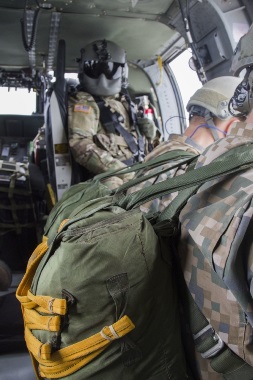
 Lielvarde, Latvia
Lielvarde, Latvia
May 17, 2017
Story by Spc. Thomas Scaggs
10th Combat Aviation Brigade
For an entire week in Latvia, parachutists caught countless gusts of wind, ropes were thrown from hovering helicopters and slammed into the ground below, and the sound of training scarcely stopped for the short pause between night and day. The U.S. Army’s aviation presence in the Baltics was doing what it does best, quickly and precisely putting boots on the ground.
Aviators from C Company, 2-10 Assault Helicopter Battalion, and B Company, 3-10 General Support Aviation Battalion, 10th Combat Aviation Brigade, 10th Mountain Division (LI), provided air support to Latvian Special Operations Forces (SOF) Soldiers from May 15-19 to train jointly on paradrops and fast-roping techniques in Lielvarde, Latvia.
The week-long training focused on some of the most elite types of troop insertion operations, simultaneously giving crews from the brigade a chance to qualify their skills in preparation for future operations and further develop the interoperability being cultivated on a daily basis in the Baltics.
“This training is very valuable because we do things a little differently than they do and vice versa,” said Chief Warrant Officer 3 Pete Latham, a UH-60 Black Hawk helicopter standardization pilot with C Company, 2-10 Assault Helicopter Battalion. “It’s great for us to come together and mesh our training plans, developing a product that maximizes training effectiveness in order to properly set the theater.”
Despite the fact that sun doesn’t begin setting until almost 10 p.m., which means it isn’t dark enough to qualify on night-vision tasks until even later in the evening, crews maintained a rigorous schedule and continued to qualify themselves and Latvian SOF members well into the night on multiple occasions.
Two types of parachute drops were executed throughout the week, and crews and jumpers were required to operate during the daytime and nighttime to fully qualify themselves. The first type, called static-line jumping, automatically opens the parachute as the jumper exits the aircraft because the parachute’s deploying cord is attached by clip to a fixed point inside. Military freefall parachuting, which is usually completed at higher altitudes, requires the jumper to deploy his or her own parachute once they reach the proper altitude.
Each type of jump was performed in both the CH-47 Chinook and the UH-60 Black Hawk helicopters at a variety of altitudes, the highest being 12,500 feet.
The third task trained during the week, called Fast Rope Insertion and Extraction System (FRIES), is an air assault technique whereby ropes are deployed from the hovering aircraft and Soldiers quickly slide down them to the desired drop zone below.
“I think it’s been a great training opportunity, especially for the younger pilots and crew chiefs,” said Chief Warrant Officer 3 Nicholas Daniels, a CH-47 Chinook instructor pilot with B Company, 3-10 General Support Aviation Battalion. “It’s also a fantastic opportunity for us to develop an understanding of our NATO allies’ forces’ capabilities and how they integrate with our aviation operations.”
Approximately 20 flight hours were logged, throughout the week, while supporting the training. With a total of over 200 jumps qualifying the Latvian Special Operations Forces and multiple U.S. Army aircrews, both allies finished the week with heightened levels of readiness and a greater understanding for how to work successfully in the future.








